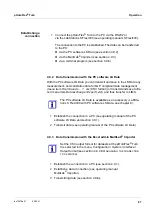
Operation
pHotoFlex
®
Turb
56
ba75976e07
09/2021
4.7
Turbidity
4.7.1 General information
Venting the sam-
ple
Air bubbles in the sample affect the measuring result to a massive extent be-
cause they have a large scattering effect on the incident light. Larger air bub-
bles cause sudden changes in the measured values whereas smaller air
bubbles are recorded by the instrument as turbidity. Therefore, avoid or re-
move air bubbles:
Avoiding or
removing air bub-
bles
During sampling, ensure all movement is kept to a minimum
If necessary, vent the sample (ultrasonic baths, heating or adding a sur-
face-active substance to reduce the surface tension)
4.7.2 Aligning and marking a cell
Even completely clean quality cells exhibit tiny directional differences in their
light transmittance. Therefore, for accurate and reproducible measurement
results, it is necessary to always align both the sample cells and the cells for
calibration standards in the same way (see section 2130 of the "Standard
Methods for the Examination of Water and Wastewater", 19
th
issue).
To do so, the optimum alignment of the cell is determined.
18 Wait for the end of the AutoRead measurement or
Terminate Auto-
Read
and accept the calibration value with
<START/ENTER>
.
The new calibration values are displayed as a piece of information
(
i
).
You have the following options:
Using
<START/ENTER>
, take over the new calibration values.
Subsequently, the calibration record is displayed and output to the
interface at the same time.
Using
<M>
(short pressure) or
<ESC>
switch to the measured val-
ue display, without taking over the new calibration values.
To measure turbidity values under 1 FNU/NTU, please heed
appendix 2 on page 101 additionally.
Never apply oily liquids to "smooth" any scratches (not even so-
called "special silicone oils"). They unnecessarily contaminate
the meter and your working environment. Measurement accuracy
is ensured by aligning the cells. Scratched cells have to be re-
placed.
















































